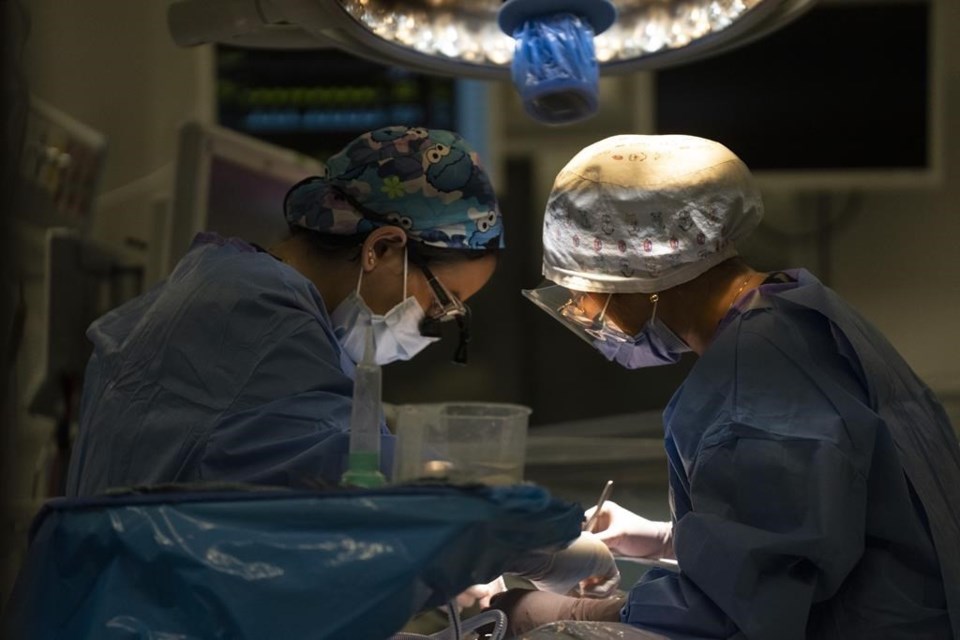Patients treated by female surgeons incur lower health-care costs than those treated by male surgeons, suggests an Ontario-based study of more than one million people.
The study examined health data for adult patients who had 25 common elective and emergency operations between 2007 and 2019. It found that one month, three months and one year after the patients' procedures, costs were about 10 per cent lower for those whose surgeon was a woman.
Dr. Angela Jerath, a cardiac anesthesiologist at Toronto's Sunnybrook Health Sciences Centre and one of the study authors, said that represents significant savings for the health-care system — estimated at about $6.7 billion over one year — but more research is needed to better understand the factors behind the cost difference.
How female surgeons communicate with patients and other members of the surgical team may play a role, said Jerath, also a professor at the University of Toronto.
"There may also be differences in how we make decisions, how we make judgments around what kind of care a patient needs, either before the procedure and after the procedure. This is an area where we're still working out what are the sex disparities in that process," she said.
"These are sections of care that are not formally taught. There's no gold standard way of how you follow someone up and keep an eye on whether -- after your surgery, for example -- you're developing a pneumonia or something like that."
So far, results of the study have received a "mixed bag" of responses, with some surgeons saying they are more conscientious and attentive while others have reacted with "anger and contempt," Jerath said.
"They're concerned about what this means for their practice, their income, their opportunities," said Jerath, adding the study should lead to more open discussion so doctors can improve their work in small ways to get better outcomes. It also calls for more inclusive policies to support female physicians who take time off to have children, she said.
Data for the study, published Wednesday in the Journal of the American Medical Association (JAMA) Surgery, was analyzed by the research institute ICES and included lab tests, hospitalizations, emergency room visits as well as patients' and physicians' characteristics, such as their sex and age.
The study included patients who essentially had the same surgery by a male or female surgeon under similar circumstances. The findings were adjusted for factors that can affect patient outcomes, including the level of any chronic diseases and the doctors' surgical and anesthesia experience.
The findings add to four other Ontario studies published since 2018, some involving Jerath, that suggest health outcomes are better for patients who have female surgeons.
They were led by Dr. Christopher Wallis, a urologic oncologist at Toronto's Mount Sinai Hospital. He is also the lead author of the current study on cost savings.
While women have achieved parity in medical schools, they face barriers including unconscious bias in traditionally male-dominated specialties, including surgery, Jerath said.
Wallis said that on average, female surgeonstake a little more time in the operating room — about 10 to 15 minutes — as part of what is believed to be a more patient-centric approach that includes counselling patients before surgery, bringing them through a stressful operation and caring for them in the recovery period.
"As a man practising surgery, I try to be introspective and reflect on what we know about the outcomes that patients with female surgeons get and what we know about the differences in how women practise medicine," he said.
"At the end of the day, this is about expertise and about relationships. So patients need to have a surgeon that they trust, that they can put their faith in and feel they can communicate well with. I think those are all factors that contribute importantly to patient outcomes," said Wallis, adding that should be the case regardless of the surgeon's gender.
The study says female surgeons tended to be younger, as were their patients who were more likely to be female and with fewer coexisting conditions compared with those treated by male surgeons.
"There were also differences in surgical specialties: patients treated by female surgeons were more likely to have undergone general, obstetric or gynecologic or plastic surgeries, while those treated by male surgeons were more likely to have undergone cardiac, neurosurgical, orthopedic, or urologic procedures," it said.
However, more women work in general surgery so that changes their patient population, and statistical models in the study accounted for those differences, Wallis said.
While the findings may be threatening to some male surgeons, changing the culture of surgery to recruit and retain more women is essential for the workforce as a whole, said Wallis, adding that about 10 per cent of the surgeons in his subspecialty of urology are women.
"Fundamentally, for many, many years, surgery has been felt to be an old boys' club and it's felt to be an environment that is unfriendly to women, both in the demands it places on you and in the culture that surrounds behaviour within surgery."
It's important for male and female surgeons to understand why better communication leads to lower health-care costs and ultimately, better care for patients, Wallis said.
This report by The Canadian Press was first published Nov. 29, 2023.
Canadian Press health coverage receives support through a partnership with the Canadian Medical Association. CP is solely responsible for this content.
Camille Bains, The Canadian Press



